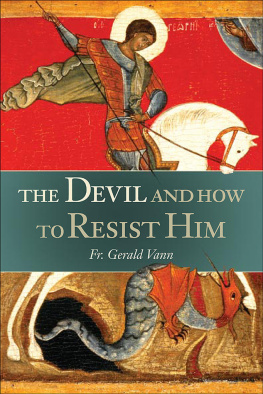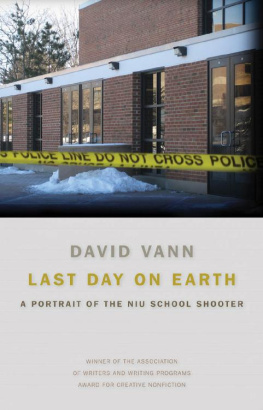Fr. Gerald Vann - The Devil: And How to Resist Him
Here you can read online Fr. Gerald Vann - The Devil: And How to Resist Him full text of the book (entire story) in english for free. Download pdf and epub, get meaning, cover and reviews about this ebook. year: 2011, publisher: Sophia Institute Press, genre: Religion. Description of the work, (preface) as well as reviews are available. Best literature library LitArk.com created for fans of good reading and offers a wide selection of genres:
Romance novel
Science fiction
Adventure
Detective
Science
History
Home and family
Prose
Art
Politics
Computer
Non-fiction
Religion
Business
Children
Humor
Choose a favorite category and find really read worthwhile books. Enjoy immersion in the world of imagination, feel the emotions of the characters or learn something new for yourself, make an fascinating discovery.
- Book:The Devil: And How to Resist Him
- Author:
- Publisher:Sophia Institute Press
- Genre:
- Year:2011
- Rating:3 / 5
- Favourites:Add to favourites
- Your mark:
- 60
- 1
- 2
- 3
- 4
- 5
The Devil: And How to Resist Him: summary, description and annotation
We offer to read an annotation, description, summary or preface (depends on what the author of the book "The Devil: And How to Resist Him" wrote himself). If you haven't found the necessary information about the book — write in the comments, we will try to find it.
The Devil: And How to Resist Him — read online for free the complete book (whole text) full work
Below is the text of the book, divided by pages. System saving the place of the last page read, allows you to conveniently read the book "The Devil: And How to Resist Him" online for free, without having to search again every time where you left off. Put a bookmark, and you can go to the page where you finished reading at any time.
Font size:
Interval:
Bookmark:


Sophia Institute Press
by Gerald Vann:
The Seven Sweet Blessings of Christ (And How to Make Them Yours)
by
Gerald Vann, O.P.
and
P. K. Meagher, O.P.
................................ 3
Chapter One
.................... 13
Chapter Two
............................ 31
Chapter Three
................... 51
Chapter Four
............................ 73
Chapter Five
..................... 105
Chapter Six
.................... 123
Chapter Seven
............................ 143
Editor's Note: The biblical references in the following pages are based on the Douay-Rheims and Ronald Knox versions of the Old and New Testaments. Where applicable, quotations have been cross-referenced with the differing names and enumeration in the Revised Standard Version, using the following symbol: (RSV =).
Do you believe in the Devil?
It seems probable that a large number of modern Christians would be somewhat embarrassed if faced with the question. Many would like to see in Satan only a symbolic representation of the evil tendencies in human nature. Others, while giving a notional assent to his existence, could hardly be said to believe effectively in him, to make that belief an active element in their lives: their assent would remain notional rather than real.
Certainly it seems that the Devil is rather played down in modern Christian teaching and writing, and we tend to discount stories, such as we find in the lives of the saints, in which he makes a personal appearance.
It seems useful to inquire why this is so.
Our purpose in this book is to study the temptations of our Lord, and the lessons to be learned from them would be there whether we took the account of them in the Gospels as historical fact or pure symbol. But to take the story simply as symbol is to rob it of a great deal of its depth. And granted that Satan does exist, it would be extremely foolish and dangerous to write him off as mere fantasy. Indeed, as the writer Denis de Rougemont has pointed out, Satan's great triumph in modern times consists precisely in having caused mankind to disbelieve in him. For if Satan is as mighty and malicious, as close to us, and as intent on our destruction as Christian tradition would have us believe, nothing could be more foolhardy than to pretend he does not exist at all.
Moreover it is a short step from disbelief in Satan to disbelief in the reality of moral evil in any form, to the view that there is never anything morally censurable in crime: that it is simply a disease, as wanting in moral significance as measles or a cold, and to be cured simply by proper medical or psychiatric treatment. Sin, too, as distinguished from the more obvious and violent forms of antisocial behavior which we call crime, has lost most of its meaning and become largely a question of outmoded social conventions or obscurantist prejudices.
Such a climate of opinion may well influence Christians, who live in it, more deeply and in more ways than they realize. It is possible, while acknowledging the reality of sin, to adopt in practice a somewhat cavalier attitude toward it, as something regrettable, of course, but inevitable and not worth all the fuss the theologians and devout writers make about it.
And where Satan is concerned, it is all too easy to accept his existence in a vague and wholly theoretical sort of way while in practice ignoring it. We are often "tempted," yes; but for the source of the temptation we need look no farther than ourselves. We know so much more nowadays than was known, for instance, in the Middle Ages about our own urges and and others have changed all that for us.
But there is something very naive and unreal about any such clear-cut distinction between temptations which spring simply from our own inclination to evil and others which might be supposed to be due entirely to the promptings of Satan. In the first place, if Satan does exist and is what Christianity holds him to be, he is far too intelligent to tempt us to forms of evil to which we have no inclination: on the contrary, he will seek to utilize our own particular propensities.
Secondly, we have to accept those propensities as realities within ourselves, yes; but how did they get there? If we look just at the imperfections, the quirks of character, in our friends and in ordinary, decent people, we may well fail to discern any sign of diabolical activity. But what if we take a larger view? If we look at the appalling burden of physical and mental anguish which weighs down the world, and at the still more appalling cruelty, malice, and stark evil which cause so much of it, shall we be so ready to believe that all this is sufficiently explained from within humanity - the humanity we know as normally so decent, so good?
We can invoke, plausibly and indeed validly enough, the psychology of sadism to explain one case of murderousness; this criminal is a diseased man just as surely as the victim of cancer or tuberculosis, and the one simply needs psychiatric treatment and torture-chambers, the slave labor camps, the massacres and mass deportations, and the modern techniques - tortures, drugs, and inverted psychiatry - that destroy not merely men's bodies but their minds. And then it becomes less easy to write Satan off as a medieval superstition.
and it is easy to see how the resultant figure seems wildly improbable to us.
We have to remember, first of all, that according to Christian thought, evil is nonbeing - a privation. Satan therefore is not evil, pure and simple, as God is pure goodness: he is an angel, and his fall did not destroy his angelic nature. So it is that some early Christian paintings depict him as a beautiful winged youth; after all, his biblical name, Lucifer, the "lightbearer," underlines this idea of beauty, of dazzling splendor.
He is said in many stories to have appeared to men under monstrous shapes; but these are momentary disguises designed to inspire terror, and are no more a representation of Satan's angelic nature than the simpering, epicene, winged young men of modern repository art are a faithful representation of the good angels.
As Marrou points out, except perhaps for the idea of guardian angels, Christian angelology means very little to us; and he points in particular to the eclipse in modern times of the archangel Michael compared with his important cultus in the Middle Ages.
We might well remind ourselves, therefore, that in this, as in so much else, we are almost alone in the world's history in and had the sense to understand the Christian reality faintly adumbrated in the naiads and dryads of the Greeks.
should suggest to us something much deeper and more sinister than a mere pagan lewdness. They should suggest something somber and subhumanly degraded, but satanic too; for the satyr is the symbol of man half-dehumanized, half turned into a goat. But traditionally it is the goat who is adored in the witches' sabbats, for it is the purpose of the warped but still mighty superhuman spirit to rob us of our humanity so as to make it impossible for us to know divinity.
Font size:
Interval:
Bookmark:
Similar books «The Devil: And How to Resist Him»
Look at similar books to The Devil: And How to Resist Him. We have selected literature similar in name and meaning in the hope of providing readers with more options to find new, interesting, not yet read works.
Discussion, reviews of the book The Devil: And How to Resist Him and just readers' own opinions. Leave your comments, write what you think about the work, its meaning or the main characters. Specify what exactly you liked and what you didn't like, and why you think so.













